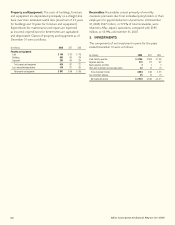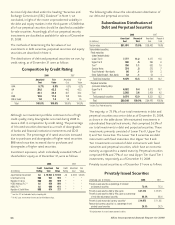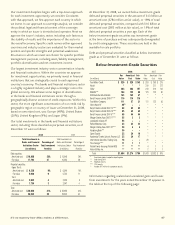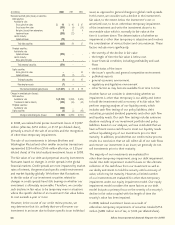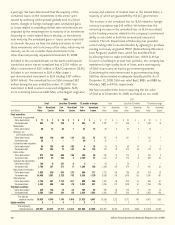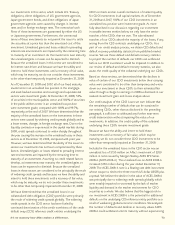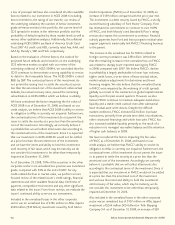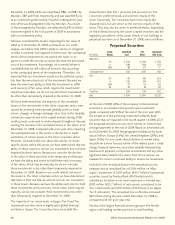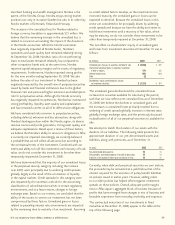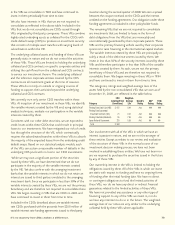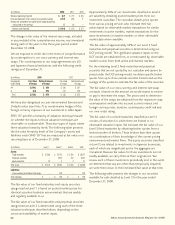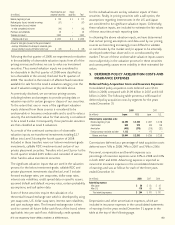Aflac 2008 Annual Report Download - page 77
Download and view the complete annual report
Please find page 77 of the 2008 Aflac annual report below. You can navigate through the pages in the report by either clicking on the pages listed below, or by using the keyword search tool below to find specific information within the annual report.
73
It’s no mystery how Aflac makes a difference.
our investments in this sector, which include U.S. Treasury
obligations, direct obligations of U.S. government agencies,
Japan government bonds, and direct obligations of Japan
government agencies were caused by changes in interest
rates and/or foreign exchange rates. The contractual cash
flows of these investments are guaranteed by either the U.S.
or Japanese governments. Furthermore, the contractual
terms of these investments do not permit the issuer to settle
the securities at a price less than the amortized cost of the
investment. Unrealized gains and losses related to prevailing
interest rate environments are impacted by the remaining time
to maturity of an investment. As the investments near maturity
the unrealized gains or losses can be expected to diminish.
Because the unrealized losses in this sector are considered to
be interest rate driven and because we have the ability and
intent to hold these investments until a recovery of fair value,
which may be maturity, we do not consider these investments
to be other-than-temporarily impaired at December 31, 2008.
As of December 31, 2008 and 2007, all of our fixed maturity
investments in an unrealized loss position in the mortgage-
and asset-backed securities and sovereign and supranational
sectors were investment grade. At December 31, 2008, 53%
of securities in the municipalities sector and 100% of securities
in the public utilities sector in an unrealized loss position
were investment grade, compared with 100% and 99.7%,
respectively, at the end of 2007. We have determined that the
majority of the unrealized losses on the investments in these
sectors were caused by widening credit spreads globally and to
a lesser extent, changes in foreign exchange rates. Due to the
liquidity contraction experienced in the capital markets during
2008, credit spreads continued to widen sharply throughout
the year causing the increase in the unrealized losses in these
sectors as of December 31, 2008, compared with prior year.
However, we have determined that the ability of the issuers to
service our investments has not been compromised by these
factors. Unrealized gains or losses related to prevailing interest
rate environments are impacted by the remaining time to
maturity of an investment. Assuming no credit related factors
develop, as investments near maturity the unrealized gains or
losses can be expected to diminish. Because the unrealized
losses in these sectors are considered to be principally the result
of widening credit spreads and because we have the ability and
intent to hold these investments until a recovery of fair value,
which may be maturity, we do not consider these investments
to be other than temporarily impaired at December 31, 2008.
We have determined that the unrealized losses in our
collateralized debt obligation (CDO) portfolio were primarily
the result of widening credit spreads globally. The widening
credit spreads in the CDO sector has been fueled by
continued deterioration of the credit worthiness of the credit
default swap (CDS) reference credit entities underlying the
CDO contracts and an overall contraction of market liquidity
for CDO investments in all capital markets. As of December
31, 2008 and 2007, 100% of our CDO investments in an
unrealized loss position were investment grade. As more
fully described in our discussion regarding our investment
in variable interest entities below, we only have the senior
tranches of the CDOs that we own. The subordinated
tranches of our CDOs absorb the majority of the losses, if any,
arising from the CDS contracts underlying our CDOs. As a
part of our credit analysis process, we obtain CDS default and
default recovery probability statistics from published market
sources. We use these default and default recovery statistics
to project the number of defaults our CDOs can withstand
before our CDO investment would be impaired. In addition to
our review of default and default recovery statistics, we also
assess the credit quality of the collateral underlying our CDOs.
Based on these reviews, we determined that the declines in
value of certain of our CDO investments below their carrying
value were considered to be other than temporary and wrote
down our investment in these CDOs to their estimated fair
value through a charge to earnings in 2008 as disclosed in our
realized investment gains and losses analysis above.
Our credit analyses of the CDO issues we own indicate that
the remaining number of defaults that can be sustained in
our existing CDOs, other than as disclosed in the preceding
paragraph, is sufficient to withstand any further near-term
credit deterioration without impairing the value of our
investments. In addition, the credit quality of the collateral
underlying these CDOs remains investment grade.
Because we have the ability and intent to hold these
investments until a recovery of fair value, which may be
maturity, we do not consider these CDO investments to be
other-than-temporarily impaired at December 31, 2008.
Included in the unrealized losses in the CDO sector was an
unrealized loss of $150 million on Aflac’s investment of $200
million in notes issued by Morgan Stanley ACES SPC Series
2008-6 (ACES 2008-6). The unrealized loss on ACES 2008-6
increased $150 million during the year ended December 31,
2008. The ACES 2008-6 note is a floating rate debt instrument
whose coupon is tied to the three-month US dollar LIBOR plus
a spread. We believe the decline in the value of ACES 2008-6
was principally due to widening credit spreads globally, which
were notably impacted or worsened by the lack of market
liquidity and demand in the market environment for CDO
securities as a whole. We also believe that the biggest risk to
our investment in ACES 2008-6 is the potential for additional
defaults on the underlying CDS reference entity portfolio as a
result of weakening global economic conditions. We analyzed
the number of defaults and declines in recovery values ACES
2008-6 could withstand until its maturity without experiencing



